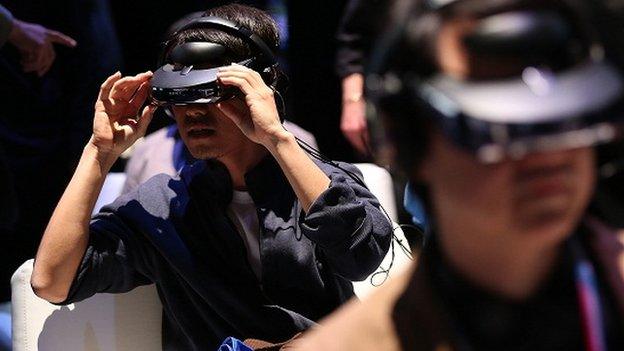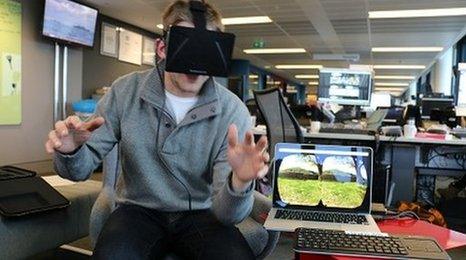Researcher creates 'holodeck' with Oculus and Kinect
- Published
Oliver Kreylos tests out his device
Oliver Kreylos has combined three Kinects with an Oculus Rift to import a 3D representation of himself into virtual reality.
The Kinects' video stream is merged before being fed into the Oculus headset, giving the impression of a solid 3D object.
In this instance, the object is Mr Kreylos, who can be seen sitting in a virtual office.
Low resolution and prone to glitches, the device is still an early prototype.
The three Kinects - peripherals for Microsoft's Xbox - are positioned in an equilateral triangle to accurately capture the subject, whose image is then beamed into Facebook's Oculus Rift headset.
Mr Kreylos is able to control the camera in such a way that he can see himself in both a first and third person perspective.
Unlike an ordinary 2D camera, the Kinect is equipped with a 3D camera, which provides the missing bits of information necessary for 3D reconstruction that a regular camera does not have.
Mr Kreylos, researcher at University of California, Davis, said in his blog that despite the low quality of the image, it still feels very real.
"I believe it's related to the uncanny valley principle, in that fuzzy 3D video that moves in a very lifelike fashion is more believable to the brain than high-quality avatars that don't quite move right."
The Uncanny Valley principle is a hypothesis that suggests human features that are designed to move similarly, but not exactly, like natural human beings - such as in robotics or 3D animation - can cause revulsion in observers.
Mr Kreylos first started experimenting with the Kinect back in 2010 and this appears to be the first time the device has been used to create this particular effect in conjunction with the Oculus Rift.
- Published8 January 2014

- Published26 March 2014

- Published26 March 2014
